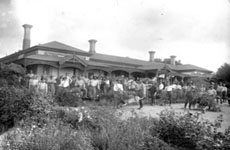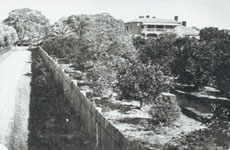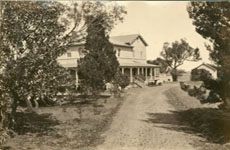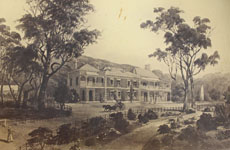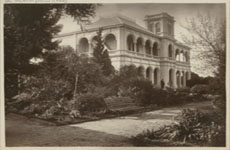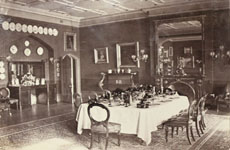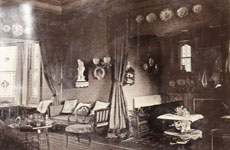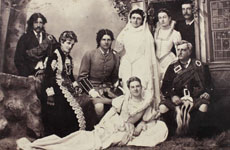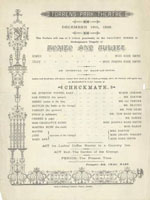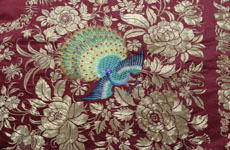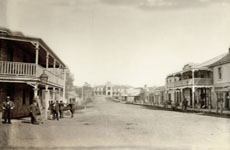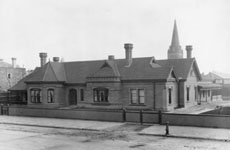The Barr Smith Homes
Robert and Joanna’s first home in South Australia was at Myrtle Bank, an eight room bluestone house built by William Sanders which had been rented in succession by Joanna’s brothers, William, George and Thomas Elder.
The Barr Smiths then moved next door to William Elder’s property Ridge Park after he returned to Scotland, but had to move out when the house was sold to William Ferguson. Ridge Park subsequently became an intermediary for the importation of Elder and Barr Smith horses.
Fayette Gosse reflected how hard the transition must have been for the new young bride:
“The crude, isolated town, created little more than twenty years earlier out of bush wilderness, with its brand new buildings, its lack of establishment and facilities, its strange landscapes and daunting gum trees, its summer heat and wildness and loneliness, was a far cry from the bracing, confining domestic life in Kirkaldy.” (p. xix)
Myrtle Bank today forms part of the War Veterans Home in Ferguson Ave. Ridge Park is now part of Ridge Park Health Care Centre for Aged Care, at 32 Cross Rd Myrtle Bank.
In 1860 they rented Oaklands, a fine two story house in Marion built by Samuel Kearne and set in 500 acres of farmland. The rich soil produced abundant crops of lucerne, oranges and grapes from which some 5,000 gallons of wine was produced in 1862. Kearne’s absentee sons inherited the property following his death in 1857. Oaklands has long since been demolished.
St Clair
In 1861, after returning from their first voyage back to Britain, the Barr Smiths with their family of two young children rented St Clair in Woodville, a fine mansion built by S. R. Clarke which had been expanded to some 30 rooms with a large ballroom by Mr John Bristow Hughes (of Bundaleer Station). He also added a second story and a he underground kitchen. They remained at St Clair for eight years during which Mabel, Tom, Jean, Joanna and Erlistoun were born. Despite disliking the disruption of building, Robert added another bedroom and dining room during their tenure. Robert complained to George Elder: “Just returned from a miserable February at Glenelg to a half-finished house at Woodville. It is not easy to say by what we suffer most but the change at least has the advantage of a drift in kind of misery.” (p. 23)
The St Clair homestead was compulsorily acquired by the Council and demolished to make way for the St Clair Recreation Centre which opened in 1962. The St Clair name survives as a local park and a new suburban development.
Birksgate
Thomas Elder bought Birksgate at Glen Osmond from the pastoralist and barrister Arthur Hardy in 1864. He immediately enlarged the house, adding another story, a gas plant for heating, and a massive conservatory shipped out from Scotland and in which he grew bananas and orchids (p. xx). The grounds also included an artificial lake, an 11 acre vineyard, paddocks for racehorses, a private zoo and a tower from which he could signal his yachts in the gulf and watch for overseas ships. On their arrival he would discharge his cannon and run up the Union Jack.
In 1869 he embarked on an extended trip to England and Scotland and offered his home to his sister and her family. They remained there for two years until Thomas’ return. Thomas Elder bequeathed Birksgate to Tom Elder Barr Smith and it remained in the family until rezoning from a rural to an urban zone forced its sale. The house was demolished to make way for a housing estate in 1972. The conservatory was relocated to Beechwood, the next home of the current Tom Barr Smith, in 1969.
The Briars
After leaving Birksgate Robert and Joanna rented The Briars in Medindie from George C. Hawker (of Bungaree Station) for four years. During this time two more children, Hugh and Ida, died while young, and Joanna gave birth to another son they named Robert, the first Robert having died some 10 years before (p. 28). Early in 1873 the family was again on the move and travelled again to England. While in England Robert negotiated to buy the Briars with plans to enlarge the house, but he suddenly purchased Torrens Park instead. George Hawker lived in the house until he died, Joanna Barr Smith having married his second son, George Charles Hawker. The Briars still stands as a private home, having been converted for a time to serve as the McBride Maternity Hospital.
Torrens Park
While in England, Robert was feeling the lack of a family home. Robert wrote to Thomas Elder:
“We have spent so much of our lives without a fixed home, that I must put my foot down now - somewhere ... the lack of it to a large family is intolerable .... In the meantime we deeply regret leaving South Australia and are by no means fascinated by the life we observe ... We have been living until last week in hotels & this is not a pleasant kind of life. It may be judging hastily but so far we do not think to have gained anything by leaving South Australia. Twenty years is a long part of one's life. Friendships are formed & interests created which do not die out at once. To tumble yourself into the midst of strangers who do not care a brass farthing for you - to subject yourself to live in a disagreeable climate where it is always raining is doubtful wisdom. I do not return however until I know where I am to go for really with my family & at my time of life a fixed home is a necessity.” (p. 31)
Torrens Park was built by Sir Robert Torrens in 1853 and then much enlarged by Walter Watson Hughes, Robert’s partner in the Moonta Mines, who had decided to remain in England. They had bought the house complete with furnishings, and on their return in 1874 the Barr Smiths immediately moved in.
Robert and Joanna were however great shoppers. They “swiftly amassed great pile of chattels in Europe to bring back with them – as if they were to enter a bare space. They never ‘travelled light’“ (p. xxi). “They bought lavishly - mosaics from Florence, glass from Prague, 320 square metres of parquet from Switzerland, a case of pictures from Rome, another case of pictures from Munich, two cases of picture frames from Florence and an assortment of Dresden china, lamps, a case of material for making ice, cases of wine, and a box of toys … Back in England Robert ordered brasses for his carriages from Birmingham and greenhouses from Brompton … They also bought five paintings by an obscure French artist, Ignace Fantin-Latour, whose work had been recommended by a friend in London." (p. 34)
Torrens Park stood in the foothills surrounded by bushland and forest with panoramic views over St Vincent’s Gulf. It remains a beautiful Gothic style building of pale local stone with a tower and narrow arched windows. Although Torrens Park had already been enlarged by Hughes, with plenty of reception rooms and stables, there was a shortage of bedrooms for the large family and staff.
The 134 acres of grounds included an orangery, a vineyard, and a banana plantation. A large conservatory had been shipped out in kit form from London which, with shade houses and heating and cooling systems, enabled the growing of exotic plants.
In 1879, the family again travelled to England. By the time they returned in 1880, Auchendarroch was finished and the enlargements to Torrens Park were completed, including more bedrooms, a larger drawing room and a new billiard room.
In 1883-85, when Robert was 60 and Joanna 49, the Barr Smiths undertook their third trip to Britain in ten years. For the next 18 months they made do in hotels and rented apartments. Robert, with is particular attention to detail, sent hundreds of letters containing detailed instructions back to South Australia regarding colours of paint, the hanging of wallpaper and mirrors, plans for bookcases and mantelpieces, the lighting and the flooring for the theatre, the plants for the garden and so on.
Robert and Joanna only enjoyed their lovely new houses for the next few years, during which Joanna hosted numerous entertainments, balls, polo matches, suppers and dinners. The house was placed in the hands of a caretaker when they moved to a house in the city. Torrens Park had been offered by Robert and Joanna for use as a military hospital during World War I, and some land was sold for building blocks. Following Robert and Joanna’s deaths, the family disposed of all of the houses and the house and about 34 acres became the private school, Scotch College.
The Torrens Park Theatre
The teenage children were forever dressing up and devising plays. In October 1882 the children and friends presented two performances of the tableau “Lochinvar” in the drawing room (p. 52). The cast included – as in the picture – Edward Hawker, Mabel, Lady Baker, George Dean, Misses Jervis and Price, Capt Haggard, and E. Colley.
During their trip to London in 1883-84, Robert indulged them by planning a little private theatre, to be entered through the greenhouses. It was a big project: a complete theatre with stage, stage machinery and dressing rooms, sets and costumes, and an auditorium twenty metres by ten to accommodate 200 people on William Morris chairs, all planned by Robert with “no architect.” (p. 54)
With their own new theatre in mind, Mabel, Jean and Joe took drama lessons in London with the former Shakespearean actress Isabella Dallas. Mabel, now twenty-three, was always the keenest performer and pleased to recite when asked.
The theatre opened in December 1885 with scenes from “Romeo and Juliet” and a two-act comedy “Checkmate” presented by Tom (now back from Cambridge), the daughters and their friends. One of the leads was called back to his regiment and his place was taken by a young professor from the University (and a future Nobel Prize winner), William Bragg. (p. 69)
The lavish social functions were often associated by concerts, recitations, plays and tableaux, and accompanied by sumptuous suppers and dinners. At times the chairs were removed so dancing could take place on the sprung floor. This rare private theatre has now been restored and used by Scotch College.
William Morris
In 1883 Robert travelled to England to set up the firm’s London office. This provided Robert and Joanna with the opportunity to browse in Morris & Company's new shop in London and to choose the quantities of carpets, curtain fabrics, wallpaper, chintzes, furniture and glassware which were to make their two houses in Adelaide remarkable repositories of the fine work of the celebrated company … (p xxii)
The poet, philosopher and designer William Morris aimed to replace the ugliness of mass produced books and furnishings by reviving the crafts of the Medieval or pre-Raphael age. Morris & Co. advised Robert and Joanna on all aspects of their furnishing and décor for Torrens Park and Auchendarroch to create the Morris look. Joanna also bought embroidery kits with silk threads and instructions for cushion covers, tablecloths and screens for her daughters to work on. Morris’ daughter May ran the embroidery section and was reputed to have been friendly with Mabel.
“The enormous quantities of items shipped out to Adelaide from 1883 onwards is staggering, and made the Barr Smith collection of William Morris products a notable one. Their son and daughters also in time became buyers, and in such quantities that the Barr Smiths’ has been assessed as Morris & Company's largest account outside Britain. Much of the collection has drifted down to descendants of the family and some is in the Art Gallery of South Australia.” (p xxii)
Auchendarroch
Following the purchase of Torrens Park, Robert bought an old coaching inn at Mt Barker in the Adelaide hills. They commissioned a young architect, John Grainger, to convert it into a cool retreat for the hot summer months – a 30 roomed house of similar magnitude to Torrens Park but more Georgian in appearance, but also decorated throughout with William Morris furnishings. It took longer to build than was promised, and they left for England in 1879 before being able to move in.
The 42 acre grounds included three acres of formal gardens and three of orchards. The family moved up for the summer months and they became part of the social life of Mt Barker, entertaining friends and neighbours and even organising a theatrical programme in the local hall. Robert drove his horse and buggy the 22 miles into his office in the morning (changing horses at Eagle on the Hill) and returned about 5 o’clock, but it was often more convenient for him to stay down in town - sometimes with Sir Thomas Elder.
Following Joanna’s death in 1919, Auchendarroch was sold at auction ending almost forty-one years of family ownership. In 1922 the Memorial Hospital purchased it as a rest and convalescent home, during which it became sadly neglected. In World War II it served as a Red Cross rest home and then a RAAF Hospital. In the early 1970s it became a cooperative family homes venture and underwent considerable restoration, before being sold to the State and suffering further neglect under the administration of the State Planning Authority. In 2000 the Wallis family purchased the property for conversion to an entertainment complex including cinemas and they have restored many of the rooms to their former William Morris glory.
Angas St
In 1899 they made their last but not very joyful trip to England. Robert was suffering from bronchitis and wished to leave the miserable climate behind, but Joanna loved the Scottish weather and landscape. All of the children were independent now and for some time Robert and Joanna had been thinking of moving into something smaller and more modern. Joanna declared she hated Torrens Park and in 1901 rented a house ‘Eothen’ in East Terrace in the city. Joanna had a fear of earthquakes and following two earthquakes in 1902 which caused cracks in Torrens Park, she refuse to remain there. In 1905 they moved into a ‘cottage’ in Angas St in Adelaide, which consisted of several reception rooms, three main bedrooms, four servants’ rooms and a servants’ hall, plus cellars and stables The grand entertainments ceased and Robert and Joanna lived quietly, although they still spent the hot summers at Mt Barker (p. xxiv, 233).
Robert turned 91 in 1915 and died a few months later. Joanna lived four more years and died suddenly in 1919 at the age of 84. Angas Street subsequently became a convent and was later demolished.
Sources
Page numbers cited are from Joanna and Robert: the Barr Smiths’ life in letters 1853-1919. Adelaide: The Barr Smith Press, 1996. Available online.
“A brief history of the suburb Woodville”
https://www.charlessturt.sa.gov.au/webdata/resources/files/Local_history_factsheet_-_Woodville.pdf
Fayette Gosse. The Gosses: an Anglo-Australian family. Canberra: Brian Clouston, 1981.
Ken Preiss & Pamela Oborn. The Torrens Park Estate: a social and architectural history. Stonyfell S. Aust., 1991.
Picture - Soldiers' Home garden at Myrtle Bank ca 1917. Courtesy of the State Library of SA PRG 280/1/9/163
Picture- ‘Oaklands’ Marion 1872. Courtesy of the State Library of SA B 23408
Picture - ‘St Clair’ by Samuel Sweet 1874. David Bower’s ‘Woodville Residence’ Courtesy of the State Library of SA B 10652
Picture - Photo of picture of Birksgate. Barr Smith photo album. Barr Smith Library
Picture - 'The Briars', Medindie 1880. Courtesy of the State Library of SA PRG 742/5/139
Picture - Torrens Park dining room ca 1882. Sir Thomas Elder photo album. Barr Smith Library
Picture - Torrens Park yellow drawing room ca 1882. Sir Thomas Elder photo album. Barr Smith Library
Picture - Tableau ‘Lochinvar’. Barr Smith photo album. Barr Smith Library
Picture - Program of Romeo & Juliet 1885. Theatre Programs Collection, Barr Smith Library
Picture - Barr Smith Family embroidered tablecloth. University Collections, The University of Adelaide
Picture - Gawler St Mt Barker with Auchendarroch in centre. Courtesy of the State Library of SA ‘Mount Barker’ B 2536
Picture - Angas Street north side near Chancery Lane. Courtesy of the State Library of SA B 5360

